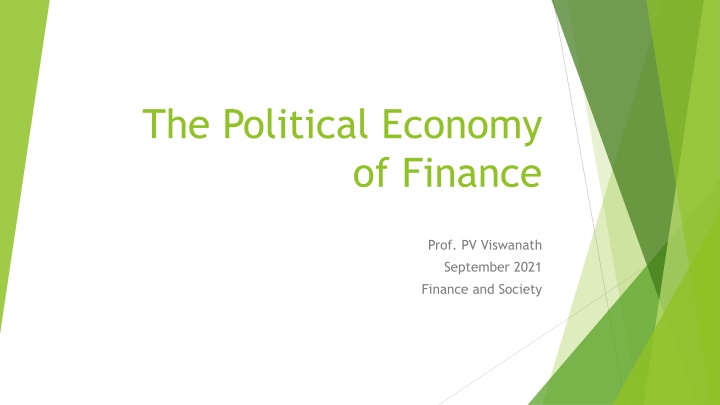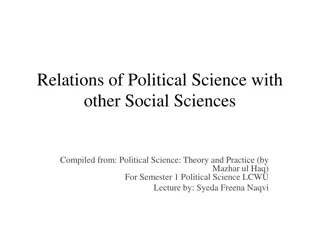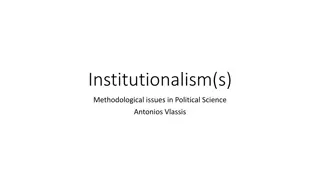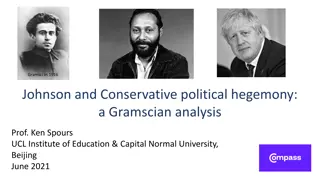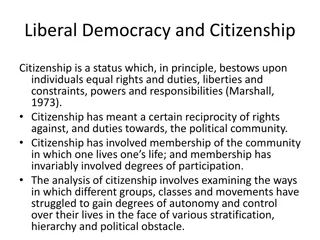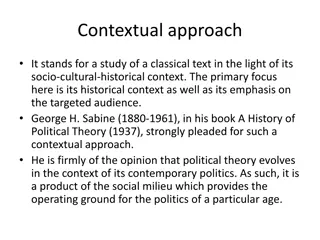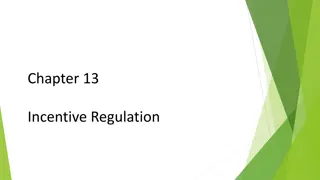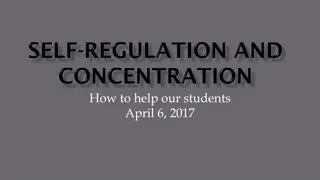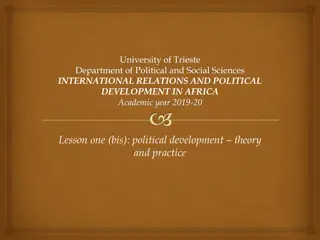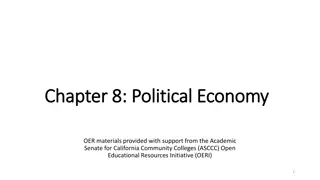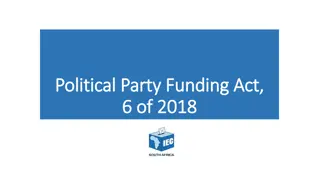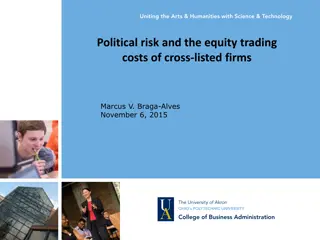Political Economy of Finance and Regulation
The interplay between political constituencies, financial institutions, and regulatory frameworks shapes economic outcomes. Understanding the dynamics of contracting institutions, political power, and economic development is essential in comprehending the complexities of modern financial systems.
Download Presentation

Please find below an Image/Link to download the presentation.
The content on the website is provided AS IS for your information and personal use only. It may not be sold, licensed, or shared on other websites without obtaining consent from the author.If you encounter any issues during the download, it is possible that the publisher has removed the file from their server.
You are allowed to download the files provided on this website for personal or commercial use, subject to the condition that they are used lawfully. All files are the property of their respective owners.
The content on the website is provided AS IS for your information and personal use only. It may not be sold, licensed, or shared on other websites without obtaining consent from the author.
E N D
Presentation Transcript
The Political Economy of Finance Prof. PV Viswanath September 2021 Finance and Society
Political economy and financial structure Why do employees select half of the board of large German companies? Why do financial regulations often stifle rather than help in the development of markets? Why do governments sometimes change the rules of the game (contracting institutions) and sometimes intervene on a limited basis? Are the impacts different? Why do some countries primarily use banks to transfer money from surplus units to deficit units, while others use stock markets? Why do some countries have creditor-friendly bankruptcy rules, while others have borrower-friendly bankruptcy rules? Why do some countries have employee-friendly legislation, while others don t?
Interplay between Political Constituencies and Regulation Regulation shapes and entrenches political constituencies via its economic effects. This can lead to vicious circles and increased inequalities (Lambert and Volpin, 2017). Electoral Competition Lobbies Regulation, Enforcement Constituencies (individuals, firms) Economic outcome This analysis assumes that political institutions are given. However, political institutions, too, are endogenous, as seen in the figure on the next slide.
Endogeneity of Political and Financial Institutions Contracting institutions are the laws and regulations that govern contracts and contractual enforcement between borrowers, investors and other corporate stakeholders. They include investor protection laws/regulations, but also other policy variables such as taxation, labor laws, competition laws, financial regulation and macroeconomic policies. Political Institutions refers to the set of formal rules typically laid down by explicit provisions in constitutions (e.g., electoral and legislative rules associated with the forms of government, such as who can vote, how power is contested and constraints on the power of politicians and elites) that determine the degree of accountability and representativeness of a political system.
The Political Economy Approach Political institutions and the distribution of resources are the fundamental variables in this framework because they change relatively slowly, and they ultimately determine financial and economic outcomes. When contracting institutions protect outside investors, they ease financial contracting by reducing agency costs and asymmetries of information and improve governance and contract enforceability, all of which is conducive to economic development. However, the prevailing set of contracting institutions depends on the relative political power of the different constituencies. The resulting contracting institutions are those that are best fit to satisfy the political wishes of the winning constituencies. The political power is highly influenced by the distribution of resources. This equilibrium outcome does not necessarily serve the common good and/or maximize economic welfare, but rather serves those who have political power.
Corporate Governance: History as determinant What determines the level of legal protection for securities market investors? Roe (1999) suggests that it is ideology. E.g. in Europe, the State is entrusted with the task of sustaining a social pact between all classes, whereby greater equality is exchanged for reduced efficiency. According to La Porta et al. (1998), it is history. Countries with commercial law regimes inspired by the French Civil code (which is more bureaucratic) have lower protection for minority shareholders and creditors. Anglo-Saxon countries that follow a common law tradition where courts tend to determine laws through precedent-setting have more protection. This may be because judicial discretion allows for more flexibility to adapt to changing circumstances. The political economy approach asks why some countries have more protection for minority shareholders and others less?
Corporate Governance: The Pagano-Volpin model The Pagano-Volpin model divides society into three competing groups: Controlling shareholders/entrepreneurs/corporate insiders Non-controlling investors Employees Controlling shareholders want low investor protection to extract larger private benefits of control. To win the support of employees in electoral competition, they make concessions to them. This is the corporatist or stakeholder model. Alternatively, controlling shareholders ally with outside investors to extract value from employees. This is the shareholder primacy model. This model implies stockholder-protection laws. When would we expect to see the corporatist outcome versus the stockholder primacy outcome?
Corporate Governance and Coalitions Insider shareholders Outsider shareholders Shareholder Primacy Model Workers Outsider shareholders CorporatistModel Insider shareholders Workers
What determines the outcome? In a majoritarian voting system, winning the majority of districts/constituencies matters; in a proportional system, winning a majority of the votes is crucial. The Pagano-Volpin model assumes that entrepreneurs care strongly about investor rights; they prefer lower investor rights. Workers care strongly about labor rights. These two are homogeneous groups. However, outsider investors don t have a strong preference one way or the other; some are more strongly in favor of labor rights and others are less strongly in favor of labor rights. This makes a difference because districts are not cross-sections of the country. In a proportional system, there is only one district, the entire country. Hence political parties would want to court the homogeneous groups. A party that is in favor of worker rights and against investor rights can win both worker and entrepreneur votes. Championing investor rights is less valuable because investors are not single-issue voters. The outcome will be a system where labor and entrepreneurs are allied and there will be more employee rights legislation. However, in a majoritarian system, there will be some constituencies where there will be enough of a concentration of outside shareholders such that a party will need to champion shareholder rights in order to win that constituency. The outcome here will be one where there is a greater tendency for entrepreneurs and outside shareholders to be allied with correspondingly greater investor rights legislation.
What determines the outcome? Pagano-Volpin hypothesize that electoral systems that move toward more majoritarian electoral rules will exhibit a relative increase in the levels of shareholder protection, while those that move towards proportional electoral rules will exhibit a relative increase in the levels of employee protection. Other factors that can also determine the outcome of the elections: The size of the different groups and their distribution over the electoral districts; if outside shareholders and workers are concentrated in some districts, the equilibrium is more likely to be a coalition of outside shareholders and workers against insiders. The extent of share ownership by employees is also important. The greater this is, the more employees are willing to accept shareholder protection and give up some employment security. the value of flexibility for managers to fire workers when desired. the tendency of outside shareholders to constitute a homogeneous voting bloc. This is more likely to tilt the balance towards investor-rights legislation.
Empirical Evidence Pagano and Volpin (2005) find empirical evidence supporting their theoretical model. In some continental European countries, the high degree of employee protection resulted from a political agreement struck in the immediate post-war period and reinforced by later legislation. In Japan, lifetime employment grew out of a postwar political deal aimed at reducing labor unrest and to restore entrepreneurs (insider) control over factories. In a multi-country study, Pagano and Volpin (2001) find that in addition to majoritarian/proportionality voting rules, rule regarding votes of confidence are also important. Where governments are subject to a confidence vote, coalition governments are more likely. Within the OECD (whose countries score highly on a proportional election measure), corporatist countries turn out to be those where coalition governments at the center are commonplace and where governments are subject to a confidence vote procedure. Hence there is a distinction between coalitions between parties and alliances between voting groups in a single party as far as corporatist outcomes are concerned. The possibility of no-confidence votes seems to strengthen the likelihood of the corporatist outcome.
Costs of Corporatism Corporatism (a stakeholder model) can lead to under-investment or under- provision of external finance because of less protection for outside shareholders. Non-controlling shareholders will restrict the availability of equity finance to companies, which will reduce the size of initial investment. This will also reduce the number of start-ups, which are dependent on external finance, as opposed to incumbent firms, which can use internal capital, i.e. retained earnings. However If there are no controlling shareholders, managers have more power and can protect their rents by lobbying politicians. In the US, therefore, managers have used regulation to restrain the power of large blockholders and banks and prevent the emergence of controlling shareholders. In Continental Europe, ownership has historically been concentrated and managers have had less power. Why have managers won out in the US and insider shareholders in Europe? Is this a historical accident reinforced through the vicious cycle mentioned earlier?
The Market for Corporate Control The political economy of takeover legislation resembles that of shareholder protection because takeovers provide weak shareholders with protection against strong managers and a way to ensure that managers act to further shareholder goals in a way that voting in a general meeting for a board is unlikely to do, given the opportunities for management to co-opt board members. Hence we can, once again, see insider shareholders/management allied with employees and pitted against outsider shareholders to support legislation that makes takeovers more difficult. The spoils, particularly for employees, are particularly strong in terms of better salaries and working conditions. Once again, owning a higher stake aligns managers with outsider shareholders and hence more willing to accept the contestability of control over the company. In this case, managers would lose private benefits qua managers, but the loss would be mitigated by a higher valuation of their shares. Golden parachutes and the like would certainly sweeten this medicine.
Banking versus Stock Markets Countries differ in terms of their dependence on stock markets versus the banking system as a means of moving resources from surplus units to deficit units. How does the political economy approach explain that? Perotti and von Thadden show that when the electorate has a sufficient degree of participation in the stock market, it will support legislation supporting outside shareholders, which will skew the system away from a reliance on banking towards the use of financial markets to raise funds for corporate investment. Concomitantly, there will be support for shareholder protection laws and a shareholder primacy model. On the other hand, when the median voter relies less on stock investments and rather on labor income, s/he will favor a greater role for banks and toward corporatism (coalition of insiders and employees) with greater creditor protection and employment protection. This approach treats creditors/banks as a separate constituency, which allies naturally with employees because both of them have debt-like claims on the firm and hence prefer less risk-taking and more stability.
Public Ownership of Companies During the years of the cold war, many eastern European and other countries had strong public sectors with government ownership of corporations. Following the fall of the Soviet Union, many of these countries as well as others (such as India) moved towards privatization. Is this a recognition of the incentive effects of private ownership? Or are there political aspects? Privatization can be undertaken by redistributive governments as well as by more conservative governments. How can a conservative government signal that it is not interested in taxing privatized company owners subsequent to privatization? A government committed to privatization and economic reform will sell enough of a stake in erstwhile state-owned companies to transfer control to the private sector, while retaining enough of a passive ownership stake to indicate its willingness to bear residual risk. If, after the sale, the government takes populist actions to reduce the value of the privatized company, the value of its stake will drop. Holding on to a minority stake will, therefore, serve as a signal that it is not interested in redistributive anti- corporate policies.
Public Ownership of Companies Groups interested in conservative proprietarian outcomes may use privatization to achieve their ends by ensuring that shares are distributed to median class voters even if it means underpricing the shares. (Proprietarianism refers to a belief in the primacy of private ownership of property.) These median class voters qua shareholders will support legislation that favors their shareholding interests and oppose legislation that is geared towards income redistribution. Political parties can tilt electorates towards or away from support for redistributive policies by giving those more likely to vote a greater interest in the corporate sector. Such policies can create a split in the electorate through creation of constituencies against redistribution. This is also likely to lead to exploitation of weaker segments of the population and to greater inequality. A government that tends more towards income and wealth redistribution will sell more of its stake at the highest price that the market can bear and then use its political power (through re-regulation, taxation, changes in regulated rates, entry deregulation, etc.) to intervene against corporations if they act against popular interests.
Banking How might political considerations enter financial reform? As recently as 1975, no state allowed out-of-state bank holding companies (BHCs) to buy in-state banks, and only fourteen states permitted statewide branching. Deregulation of bank branching in the US has been determined by the relative strength of the interest groups affected by the reform. Branching deregulation most stood to benefit bank customers who had no alternative to bank finance, since branching regulations provided local banks with greater monopoly power. Such customers were small companies, who could not have recourse to capital markets to raise funds. States where there were many such small companies tended to allow bank branching sooner. Similarly states where there were larger banks would deregulate earlier since these larger banks could withstand the greater competition in a deregulated regime with more bank branching.
Bankruptcy laws, bailouts and moratoria Deuteronomy 15: 1, 2: Every seventh year you shall practice remission of debts. This shall be the nature of the remission: every creditor shall remit the due that he claims from his fellow; he shall not dun his fellow or kinsman, for the remission proclaimed is of the Lord. Babylonian Talmud Gittin 36a: The mishna taught that Hillel the Elder instituted a document that prevents the Sabbatical Year from abrogating an outstanding debt [prosbol]. We learned in a mishna there (Shevi it 10:3): If one writes a prosbol, the Sabbatical Year does not abrogate debt. This is one of the matters that Hillel the Elder instituted because he saw that the people of the nation were refraining from lending to one another around the time of the Sabbatical Year, as they were concerned that the debtor would not repay the loan, and they violated that which is written in the Torah: Beware that there be not a base thought in your heart, saying: The seventh year, the year of release, is at hand; and your eye be evil against your needy brother, and you give him nothing (Deuteronomy 15:9). He arose and instituted the prosbol so that it would also be possible to collect those debts in order to ensure that people would continue to give loans.
Bankruptcy laws, bailouts and moratoria Strong creditor-friendly bankruptcy laws promote ex-ante efficiency in encouraging the provision of credit by lenders, who are secure in their property rights. On the other hand, there could be ex-post inefficiencies. Holders of collateral may strip the company of key assets and force its inefficient liquidation. Such liquidation can have negative externalities for employees, who have invested in firm-specific human capital or on suppliers or customers who depend on the firm s continued operation. Overly strong creditor rights on collateral would reduce their incentive to screen loan applications and permit socially inefficient investments. Poor citizens favor a soft bankruptcy law, which reduces social costs of liquidation while upwardly mobile middle-class citizens prefer tough laws that improves their access to credit.
Bankruptcy Reform The Bankruptcy Reform Act of 1978 reflected the interests of organized lobbyists, such as banks and other large creditors, bankruptcy judges, and the institutional interests of members of Congress (Eric Posner, 1997) The Act strengthened the powers of bankruptcy judges and trustees, which increased Congress members patronage opportunities. The provisions on business reorganization (e.g. the cram-down rule) resulted from efforts by managers' lawyers and large creditors to maximize their influence on the reorganization of distressed firms, at the expense of other interests, such as equity and small debt. Who stands to gain and who stands to lose in the question of student loan forgiveness?
Politics and Securities Markets Well-functioning securities markets require regulation that minimizes the information asymmetries between market participants. The repression of insider trading and the timely disclosure and dissemination of information by publicly traded companies can reduce adverse selection problems in securities markets. Adverse selection refers to the tendency of the worst firms to sell their securities. To the extent that adverse selection generates gains for informed speculators and inflicts losses on uninformed investors, the latter require an ex ante discount on the price of securities when these are issued. Equivalently, adverse selection in securities markets translates into a higher cost of external capital for companies. More developed capital markets are better for potential competitors rather than for incumbents because incumbents can finance investment opportunities with retained earnings. Established businesses will favor lax insider trading rules and weak enforcement. However, if product markets are open to foreign competition, incumbents do not have a special advantage any more and are more open to securities markets development.
Democratization of Investment Robinhood Users Come Under Attack, Vlad Tenev, CEO & co-founder of Robinhood Markets, Sept. 27, 2021. Some critics say the app is gamified, but building wealth should be fun, not complex and difficult. (Text of article follows.) Amid the turmoil caused by the global pandemic, people who had been left behind by Wall Street started investing and creating wealth like never before. But now market gadflies, academics, and out-of-touch investors are attacking commission-free, no- minimum brokerages, potentially limiting access to capital markets. The democratization of investing is no accident. Following Robinhood s lead, many brokerages across the industry dropped commissions in late 2019 after charging them for decades. By one estimate, this put about $13 billion back in the hands of retail investors. We ve helped a generation of digitally savvy customers engage with and understand investing. Our business has come under attack by critics who insist that our platform is gamified. They point to features such as lists of stocks and exchange-traded funds that help people discover investments and notifications about stock movements that help them stay informed. We designed these features, many of which are common in our industry, to make it easier and more delightful for users to stay informed. Investing isn t a game, but must it be grim and difficult to understand?
Democratization of Investment Meanwhile, some critics decry not only modern investing platforms, but also the people who use them, suggesting that new investors are uninformed gamblers looking to get rich quick. Not only are these stereotypes offensive, but the data tell a far different story. According to the Finra Foundation, many new investors in 2020 began saving for retirement with a small amount of money. Robinhood s own surveys indicate that our customers about half of whom tell us at sign-up that they are new to investing are more racially diverse than those at traditional brokerages. Payment for order flow also is in the regulatory crosshairs. Robinhood accepts payments from market makers that execute our customers trades at better prices than are generally available on exchanges. Brokerage firms have used this practice for decades. Before Robinhood, most firms received payment for order flow and charged upfront commissions. The money brokerages like Robinhood get from these market makers lets us offer commission-free investing without minimums, which has helped a new generation of retail investors get started. A ban on payment for order flow is unlikely to help retail investors get better prices and would likely re-erect barriers that kept so many out of the market.
Democratization of Investment The democratization of markets threatens the existing order. New investors are trying to build stable financial futures and reverse the inequities that plague our society. One wonders whether the push to ban payment for order flow and overregulate modern design is about investor protection or really about control. Whatever the motivation, making it more difficult to invest would hurt those who were shut out of the financial system for decades. Many Americans face suffocating debt and financial challenges, and more regulation would make it harder to build wealth. Rather than regulating financial innovators out of existence, it is in our collective interest to embrace technology, business models and policies that make it possible to build a more diverse generation of investors one that looks like America. https://www.wsj.com/articles/robinhood-users-regulation-retail-investing- order-flow-access-to-capital-investing-11632776071
Questions to ask in a critical reading Who are the interest groups in this case? Who is benefited by the resurgence of firms like Robinhood? Do not accept Mr. Tenev s statements at face value? Who is benefited by payments for order flow? What are the alternatives available to the interest groups to achieve their goals? (For example, is the legislative/lobbying method accessible to ordinary investors?)
Takeaways and questions The rules of the game are not exogenous. They are likely to be the outcome of lobbying and the outcome of relative strengths of different interest groups. What are the chances of student debt cancellation legislation that has been proposed? Who are the interest groups? What are their strengths? Is this related to the structure of the American political system in terms of the entrenched two- party system? Think of who constitute interest groups. Areas for potential lobbying and outcomes dependent on a political process: Tax policies Fiscal policies Monetary policies (cf. recent discussion on ethics rules related to QE (https://www.politico.com/news/2021/09/16/powell-fed-ethics-trading-512233) Usury laws Reporting and disclosure laws Marco Pagano and Paolo Volpin, The Political Economy of Finance, Review of Economic Policy, 2001, vol. 17, no. 4, 502-519 (http://faculty.london.edu/pvolpin/review.pdf)
Examples of interest groups affecting outcomes Co-determination in Germany gives representation to labor on corporate boards. This tends to shield management from the market for corporate control by reinforcing employees power to resist mergers of takeovers Diminishes control over management by fractionalizing the supervisory board and making it a vehicle for collusion between managers and workers. Creation of Conrail in 1976 under the pressure of customers, existing claimants and employees led to government cash inflows to Conrail. In 1997, Krupp made a hostile bid for Thyssen AG in Germany. Workers Unions helped prevent a successful conclusion to this bid. Case-by-case government interventions can have an impact on rules For example, frequent government bailouts of distressed banks can cause bank managers to see this as systematic policy and hence change their attitudes towards risk-taking. This is called moral hazard. What are the possible effects of the Chinese governments continued bailouts of large firms in 2021? When do governments decide that moral hazard issues are important (Lehmann) and when do they intervene?
Bibliography Lambert, Thomas and Paolo Volpin. 2017. Endogenous Political Institutions and Financial Development, Handbook of Finance and Development edited byThorsten Beck and Ross Levine (Edward Elgar Publishing). Roe, Mark, 2003, Political Determinants of Corporate Governance: Political Context, Corporate Impact (Oxford University Press, Oxford). LaPorta
